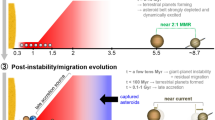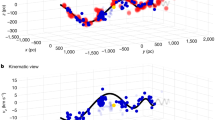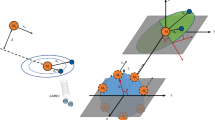Abstract
It is widely believed that meteorites originate in the asteroid belt, but the precise dynamical mechanism whereby material is transported to Earth has eluded discovery. The observational data for the ordinary chondrites, the most common meteorites, impose severe constraints on any proposed mechanism. The ordinary chondrites are not strongly shocked, their cosmic ray exposure ages are typically <20 Myr, their radiants are concentrated near the antapex of Earth's motion and they show a pronounced ‘afternoon excess’ (for every meteorite which falls in the morning two fall in the afternoon). Wetherill1 concluded that these data could only be explained by an “unobserved source” of material with perihelia near 1.0 AU and aphelia near Jupiter. His subsequent, more sophisticated investigations have not changed this basic conclusion. Recently I have shown2,3 that there is a large chaotic zone in the phase space near the 3/1 mean motion commensurability with Jupiter and that the chaotic trajectories within this zone have particularly large variations in orbital eccentricity. Since asteroidal debris is quite easily injected into this chaotic zone, it could provide Wetherill's ‘unobserved source’ if chaotic trajectories which begin at asteroidal eccentricities (e<0.2) reach such large eccentricities that Earth's orbit is crossed (e>0.57)4. In this report I present a numerical integration which demonstrates that at least some of these chaotic trajectories do have the properties required to transport meteoritic material from the asteroid belt to Earth. Combined with the Monte Carlo calculations which show that the resulting meteorites are consistent with all the observational constraints, the case for this chaotic route to Earth is fairly strong.
This is a preview of subscription content, access via your institution
Access options
Subscribe to this journal
Receive 51 print issues and online access
$199.00 per year
only $3.90 per issue
Buy this article
- Purchase on Springer Link
- Instant access to full article PDF
Prices may be subject to local taxes which are calculated during checkout
Similar content being viewed by others
References
Wetherill, G. W. Science 159, 79–82 (1968).
Wisdom, J. Astr. J. 87, 577–593 (1982).
Wisdom, J. Icarus 56, 51–74 (1983).
Wisdom, J. Meteoritics 18, 422–423 (1983).
Wetherill, G. W. Meteoritics 19, 335 (1984).
Wetherill, G. W. Meteoritics (in the press).
Scholl, H. & Froeschlé, C. in Comets, Asteroids, Meteorites; Interrelations, Evolution and Origins (ed. Delsemme, A. H.) 293–295 (University of Toledo Press, 1977).
Arnold, J. R. Astrophys. J. 141, 1536–1556 (1965).
Wetherill, G. W. in Origin and Distribution of the Elements (ed. Ahrens, L. H.) 423–443 (Pergamon, Oxford, 1968); Icarus 37, 96–112 (1979).
Greenberg, R. & Chapman, C. R. Icarus 55, 455–481 (1983).
Chirikov, B. V. Phys. Rep. 52, 263–379 (1979).
Schubart, J. Smithsonian Astrophys. Obs. Spec. Rep. No. 149 (1964).
Giffen, R. Astr. Astrophys. 23, 387–403 (1973).
Scholl, H. & Froeschlé, C. Astr. Astrophys. 33, 455–458 (1974).
Froeschlé, C. & Scholl, H. Astr. Astrophys. 42, 457–463 (1975).
Murray, C. D. & Fox, K. Icarus 59, 221–233 (1984).
Bulirsch, R. & Stoer, J. Numerische Math. 8, 1–13 (1966).
Cohen, C. J., Hubbard, E. C. & Oesterwinter, C. Astr. Pap. of the American Ephemeris 22, l (1973).
Eckert, W. J., Brouwer, D. & Clemence, G. M. Astr. Pap. of the American Ephemeris 12 (1951).
Benettin, G., Casartelli, M., Galgani, L., Giorgilli, A. & Strelcyn, J.-M. Nuovo Cim. 44, 183–195 (1978).
Berger, A. L. Astr. Astrophys. 51, 127–135 (1976).
Brouwer, D. & van Woerkom, A. J. J. Astr. Pap. of the American Ephemeris 12, 2 (1950).
Author information
Authors and Affiliations
Rights and permissions
About this article
Cite this article
Wisdom, J. Meteorites may follow a chaotic route to Earth. Nature 315, 731–733 (1985). https://doi.org/10.1038/315731a0
Received:
Accepted:
Published:
Issue Date:
DOI: https://doi.org/10.1038/315731a0
This article is cited by
-
A spherical chaotic system
Nonlinear Dynamics (2015)
-
The Origin and Evolution of the Asteroid Belt—Implications for Vesta and Ceres
Space Science Reviews (2011)
-
Surface Composition of Vesta: Issues and Integrated Approach
Space Science Reviews (2011)
-
An age–colour relationship for main-belt S-complex asteroids
Nature (2004)
-
The role of chaotic resonances in the Solar System
Nature (2001)
Comments
By submitting a comment you agree to abide by our Terms and Community Guidelines. If you find something abusive or that does not comply with our terms or guidelines please flag it as inappropriate.



